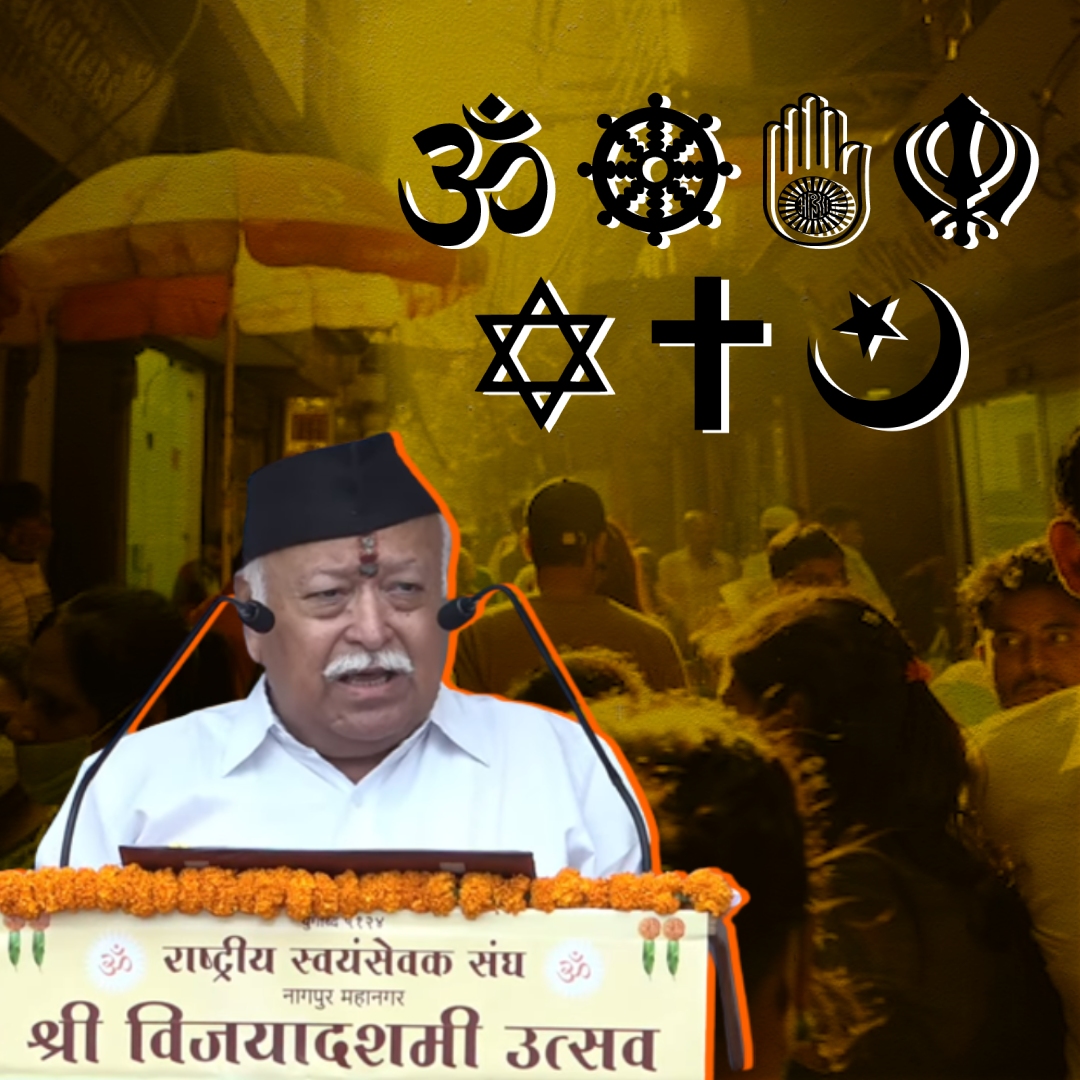
Image Credit: YouTube/RSS, Wikipedia
No, India Does Not Have Religion-Induced Population Imbalance As RSS Chief Mohan Bhagwat Claims
India, 9 Oct 2022 11:15 AM GMT
Editor : Bharat Nayak |
As the founding editor, Bharat had been heading the newsroom during the formation years of the organization and worked towards editorial policies, conceptualizing and designing campaign strategies and collaborations. He believes that through the use of digital media, one could engage the millennial's in rational conversations about pertinent social issues, provoking them to think and bring a behavioral change accordingly.
Creatives : Jakir Hassan
A journalist at heart loves the in-depth work of reporting, writing, editing, research, and data analysis. A digital and social media enthusiast.
We found that migration, conversion, and fertility rates are fluctuating factors that cause religious groups to shrink or expand. As per the data, Muslims in India are not likely to surpass Hindus in terms of population. Mohan Bhagwat’s claim that migration and conversion are causing a ‘population imbalance’ holds no backing as per the data.
Rashtriya Swayamsevak Sangh Chief Mohan Bhagwat recently demanded a 'population control policy' that would apply to all citizens of India. The RSS chief demanded the policy in a speech at an event organised on the occasion of Vijayadashmi at the RSS headquarters in Nagpur.
Bhagwat claimed that the policy was required due to what he claims as 'religion-induced population imbalance'. Previously, Union Minister Giriraj Singh, Minister of Law and Justice Kiren Rijju, and the Shiv Sena leaders have made similar claims targetting the Muslim community.
Claim:
In a speech uploaded on the YouTube channel of the RSS, the comments by Mohan Bhagwat can be heard from the 2.17.30 mark. "Fifty years ago, we suffered the consequences when there was an imbalance in the population. This hasn't happened just with us. Today, countries like East Timor, South Sudan and Kosovo have been created due to religion-induced population imbalance," Bhagwat can be heard saying.
Bhagwat says in the speech that population imbalance leads to the geographical changes in boundaries of countries. He claims that the forceful conversions, differences in fertility rates, infiltration of national borders and lure or greed are factors leading to population imbalance.
Fact Check:
The Logical Indian Fact-Check team verified the viral claim and found it to misleading. Mohan Bhagwat's claim that migration and conversion are causing a 'population imbalance' holds no backing as per the data.
We conducted a keyword search using the terms 'Mohan Bhagwat population control policy.' We came across this report in The Hindu, published on October 6, 2022.
The Hindu report talked about Chief Minister Pinarayi Vijayan criticism of Mohan Bhagwat's demand for a population control policy for all citizens of India, irrespective of religious differences. Vijayan referred to Bhagawat's statement as Islamophobic and patently anti-minority. The article notes that population increase calculations are inferred from the Total Fertility Rate (TFR).
The Hindu report quotes the National Health Survey, which shows that in the past 20 years, the TFR of Muslims has seen a steady decline. The TFR of Muslims was 4.4 in 1992-93, which dropped to 2.3 as per the latest report.
The report noted that the community's TFR had reduced by 46.5% compared to Hindus (41.2%). "As per the census, the Muslim population has dropped by 4.7% compared to Hindus (3.1%)," the Hindu report notes.
We went through the National Family Health Survey reports from 1992-93 and 2019-21. We found that all religious groups in the country have experienced a fall in TFR. The fertility rate is the highest among Muslims. However, it has been steadily dropping over the years.
In the Hindu community, the TFR declined from 3.3 in NFHS-1 to 1.94 in NFHS-5. The Christian community witnessed a drop in fertility rate from 2.87 to 1.88, and the Sikh community saw a reduction in TFR from 2.43 to 1.6 in NFHS-1.
To understand the population composition of religious groups in India, we conducted another keyword search and came across this report by Pew Research Center published on September 21, 2021.
As per the Pew report, Hindus made up 79.8 per cent of India's population in the 2011 census. In the 1951 census, the population of Hindus was recorded at 84.1 per cent, registering the fall in the Hindu population in India at a rate of 4.3 percentage points. The Muslim population has increased in India by 4.4 percentage points since 1951 from 9.4 to 14.2 per cent. The population of the other significant religions, Sikhs, Buddhists, Christians, and Jains comparatively remained unchanged from 1951 to 2011.
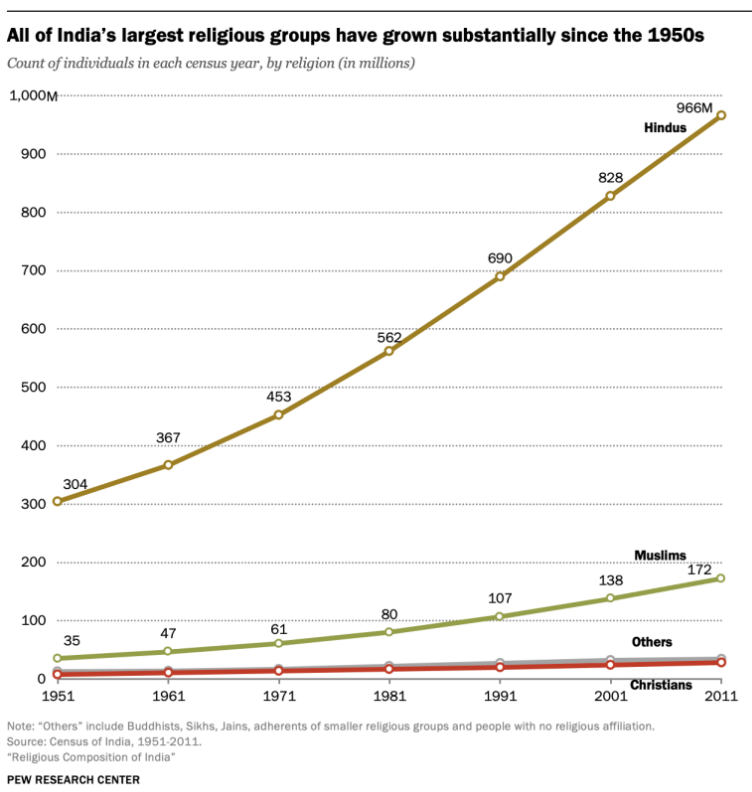
We also came across another report by Pew Research Center, which provided more information about the decline in population growth among religious groups in India.
The following graph illustrates how there has been a decline in fertility rates amongst all major religions in India.
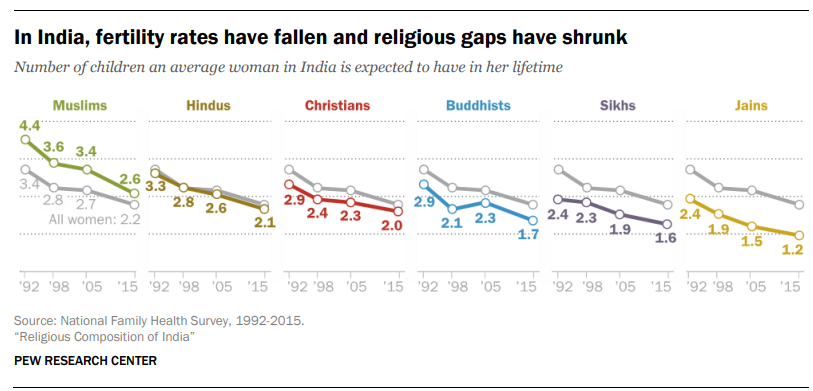
As per the report, migration, conversion, and fertility rates are factors that cause religious groups to shrink or expand. However, since the 1950s, migration has had a limited impact on India's religious composition. One of the reasons ascribed to this, as per the Pew Research report, is that more than 99% of people who live in India were also born in India.
The Pew Research report noted that 98 per cent of Indian adults identified with the religion that they were raised within. Regarding fertility rates, a woman's education level informs when she will have a child. Education provides women with several economic opportunities, such as jobs leading to further delays in childbearing, as per the report. Accordingly, economic backgrounds and geographical locations also has an impact on the number of children a woman had.
Rising fertility in some sections of society was caused due to sex selection at birth. Families tended to have more children due to the hope for a male child, or they conduct sex-selective abortions to acquire a male child.
The Pew Research report also carried a note saying that the population of Muslims in India would grow gradually, but Hindus would continue to remain a large majority.
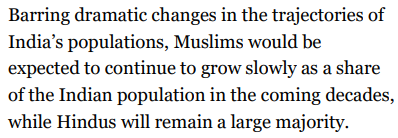
In our Fact Check, we also came across the decadal growth rate of the religious populations on the Census 2011 website. Observing the decadal growth rate of the Hindu population, it slowed from 19.92 per cent between 1991 and 2001 to 16.76 per cent between 2001 and 2011.
During the same time, with regard to the Muslim population, the decadal growth rate fell from 29.52 per cent to 24.6 per cent.
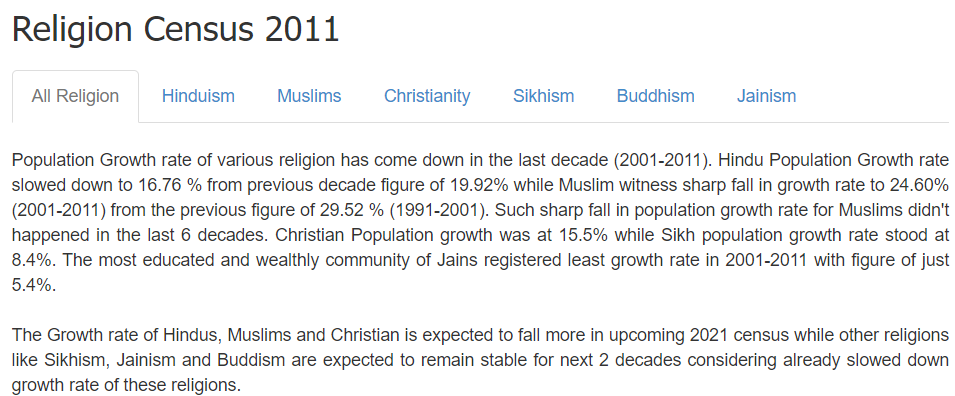
We also came across the report by the Sachar Committee published in 2006 by the Ministry of Minority Affairs. The report stated that the Muslim population will reach replacement fertility and stabilise at under 19 per cent of the population of India at a projected figure of 320 million Muslims.

Conclusion:
We found that migration, conversion, and fertility rates are fluctuating factors that cause religious groups to shrink or expand. As per the data, Muslims in India are not likely to surpass Hindus in terms of population.
Mohan Bhagwat's claim that migration and conversion are causing a 'population imbalance' holds no backing as per the data. Thus, we can ascertain that the claims by the RSS chief are misleading.
The Quint has already fact-checked the claim.
If you have any news that you believe needs to be fact-checked, please email us at factcheck@thelogicalindian.com or WhatsApp at 6364000343.
Also Read: Does This Video Show Muslims Assaulting Hindus In Birmingham, Uk? No, Viral Claim Is False
 All section
All section














